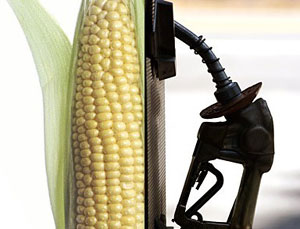By Cheryl Kaften
Could corn ethanol finally fade away?
Last December, Senators Dianne Feinstein (D-CA) and Tom Coburn (R-OK) took a bold step – they introduced legislation to eliminate the mandate that puts 10% corn ethanol into every gallon of gas at the pump – the Corn Ethanol Mandate Elimination Act of 2013.
The previous year, Congress allowed the industry’s tax breaks to expire.
Says Senator Feinstein in her blog: "I am pleased to join Senator Coburn and others on a bill to eliminate the federal corn ethanol
mandate from the Renewable Fuel Standard (RFS), while maintaining provisions designed to grow the low-carbon biofuel industry.
"Under the corn ethanol mandate in the RFS, roughly 44% of U.S. corn is diverted from food to fuel, pushing up the cost of food and animal feed and damaging the environment. Oil companies
are also unable to blend more corn ethanol into gasoline without causing problems for automobiles, boats and other vehicles. I strongly support requiring a shift to low-carbon advanced biofuel, including biodiesel, cellulosic ethanol and other revolutionary fuels. But a corn ethanol mandate is simply bad policy."
The legislation came shortly after the U.S. Environmental Protection Agency – for the first time – proposed lower volumes of ethanol for 2014. EPA proposes that ethanol volumes be reduced by 3 billion gallons, to 15.21 billion gallons this year.

The lower volume is necessary to prevent ethanol levels from growing to more than 10% in gasoline blends because petroleum demand in the US is down. Unless vehicles can handle E15 (15% of ethanol), the additional ethanol can cause problems in gasoline engines. It could also raise prices at the pump. Ford, GM and Honda say all their vehicles are approved for E15, but others aren’t.
That set up a firestorm which continues to this day, with the petroleum industry strongly in favor (which wants the Renewable Fuel Standard repealed) and the ethanol industry and corn-producing states strongly against the change.
In fact, the ethanol industry is lobbying for an ethanol blend of 15%. Bob Dinneen, President of the Renewable Fuels Association (the trade association for the ethanol industry) says cutting the mandate after farmers harvested the largest corn crop in US history (14 billion bushels, a 30% increase from 2012), is "monumentally stupid." "This legislation ought to be entitled ‘The Oil Monopoly Protection Act of 2013,’" he told The Hill.
Also in favor getting rid of the ethanol mandate are these industries: prepared food industry; dairy, beef and poultry (they want the corn to feed animals); engine manufacturers and boaters; hunger relief organizations and environmental groups (who don’t want corn to dominate agricultural acreage over many other crops).
Many studies show that corn ethanol supports have been very costly, because it’s produced and transported using fossil fuels (more greenhouse gas emissions), and encourages further clearing of land for food, which is decimating remaining native prairies.
On the other hand, ethanol plants have become much more efficient especially compared to much dirtier Canadian tar sands fuel, which is increasingly being used in the US.
The use of ethanol has supplanted billions of gallons of petroleum, part of the reason for lower oil demand. That’s the source of the oil industry’s ferver over the issue – it threatens the industry’s de facto monopoly on transportation fuels. Reining in or preferably repealing the Renewable Fuel Standard is a top priority for oil companies.
Cellulosic Mandate Stays In Tact
The purpose of the Renewable Fuel Standard, signed into law in 2007, is to spur the growth of clean fuels. To do so, EPA is required to set targets each year. Since corn has been the main source of available biofuels, it so far has dominated the mix.
Under EPA’s 2014 proprosal, 15.21 billion gallons of renewable fuels would have to blended into petroleum fuels this year – 13.01 billion from corn ethanol and 2.2 billion from advanced biofuels.
EPA also dramatically reduced the requirement for advanced cellulosic biofuels for 2014 – just 17 million gallons, compared to the 1.75 billion gallon target required under the law – for fuels made from plant-based material such as agricultural waste and grasses.
That’s because there simply isn’t much cellulosic biofuels being produced yet, given that the first plants of any size just came online last year.
Cellulosic biofuels have their own set of problems, such as extensive plantings of invasive plants.
The other target stays the same – 1.28 billion gallons of biodiesel – fuel made from soybean oil, animal fats and used cooking grease.
The Renewable Fuel Standard calls for 21 billion gallons of advanced biofuel production by 2022.
Read our article, Can Biofuels Make a Dent in Replacing Petroleum?

Mr dinneen fails to understand is we have enough corn.We do not have enough gas demand to blend it with.The Ethanol industry wants the law to allow them to blend Ethanol into an imaginary product. And have Consumers to pay for all the new blender pumps that will be required.
First of all, Bob Dinneen is a scumbag lobbyist. On top of that, ethanol is splashed mixed, which is not really mixed at all. At any given time, you can have anywhere from (10% – 20%) ethanol at the pump depending on the level of the tank in the ground. It ruins your car and you have to pay a premium for ethanol free gas which is un-American. How this ever happened is further proof that the US is doomed.